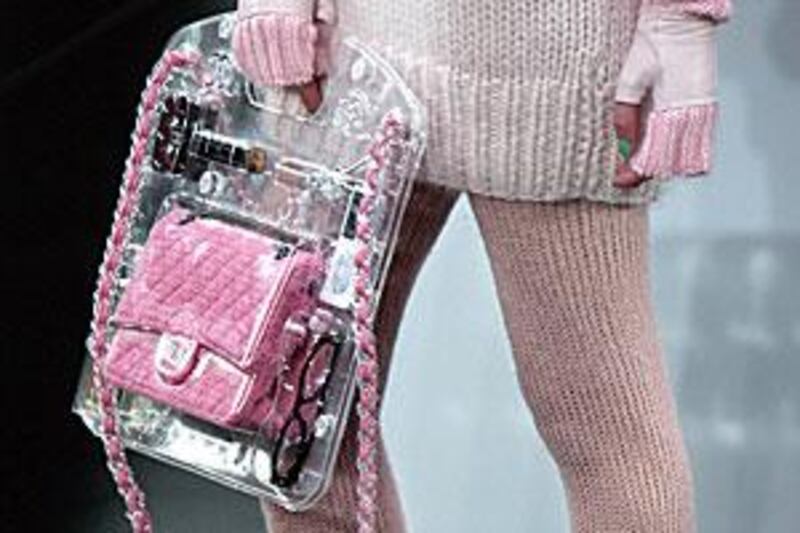However fabulous, exciting, starry and provocative they might be, catwalk shows do not always do justice to the clothes that they are supposed to display. It is at the "re-sees" that the press can examine the looks in person, and the pieces worn at Dior's Friday show perfectly illustrate this point. Clothes that looked merely pretty on the catwalk revealed their true luxury up close at Tuesday's press re-see, with cloud-soft fabrics, exquisite beading and complex cutting and tailoring forming the show's recurring themes.
The Chanel show on Tuesday was spectacular of course - as ever, the Grand Palais played host to a major set that divided the catwalk with a series of walls and doorways in stark white against which the clothes played well, though it was frustrating for people-watchers, as it hid one side of the audience from the other. (Kate Moss was interested in her neighbours Jamie Hince and Mario Testino, but the rest of the room was interested in Kate Moss.)
Graphically effective though it was, it rendered the black clothes merely black, flattening out texture that reveals the workmanship. This does the "snapshot" job that we, the press, demand for our publications, but it hides the embroidery that mimics bouclé tweed on the suits and the detail of the ruffs. Apparently inspired by Beau Brummell, the 18th-century English dandy, Karl Lagerfeld seemed, in fact, to be channelling his own personal style, with slender black suits and high white collars. In a strange twist he then used knits in pale pink and sage green for legwarmers, hats and frills that spoke of Eighties dolls - even down to a bag that mimicked toy packaging, compartmentalising a quilted bag and its contents into a flat, clear plastic pack. If the knitted hats were reminiscent of loo roll holders, the rest of the collection was as elegant as the Chanel customer would expect, delighting the audience, which also included Freida Pinto, Claudia Schiffer and Beth Ditto.
While it's clearly better to see the looks worn by a model than hanging limply in a showroom, the stalking gait of the catwalk can be misleading - wonderful when swathes of chiffon ripple from behind, but not exactly realistic. Agnès b's film presentation, though, at a decrepit but beautiful Chinese-style theatre, La Pagode, reflected the youthful, gamine charm of the clothes in a way that stroppy catwalk mannequins could not. The grey schoolboyish suits, with their slender cropped trousers, the flat shoes in bright red or black and the cute little tartan minis were shown off by playful models moving like real people, bringing a welcome simplicity to a season that has thus far been almost too sophisticated.
A designer that no one could accuse of being too sophisticated, Jean-Charles de Castelbajac again showed a bright, fun but entirely literal collection, replacing last season's Obama prints with a Muppet Show theme that saw puffball skirts printed with puppet characters, a stole made of Kermit the Frog toys sewn together and even a hat made in the shape of Animal. A young Michael Jackson and Clint Eastwood also made it onto the front of de Castelbajac's dresses, and while the collection was not to everyone's taste, it at least livened up the day.
Less lively, though extremely successful, was the first ready-to-wear outing for Valentino by the design duo Maria Grazia Chiuri et Pier Paolo Piccioli. After mixed reviews for their couture in January, it was with relief that the audience received their collection of rich colours and embellishment, deceptively simple evening gowns and desirable coats and daywear. Both Valentino veterans of many years, they clearly know how to please their customer on the shop floor and on the catwalk.
Of course, there are certain designers for whom the catwalk show is the only way to work out the full vision of their creativity, and Alexander McQueen is one. On a gleaming runway covered in the blackened debris of previous shows, his models stalked out in a spectacular series of exaggerated suits and dresses of the extraordinary, eccentric type that haven't graced a fashion week since the Eighties heyday of Thierry Mugler and Jean Paul Gaultier. Made up to resemble the late performance artist Leigh Bowery, the models pouted and posed down the runway, throwing shapes for all they were worth and enhancing the drama that McQueen's collections never fail to create. Standout pieces included the giant dogtooth check print that morphed into birds and the dramatic New Look silhouettes, complete with saucer hats (made of car hubs). Yet beneath the wonderful, almost parodic fabulousness, it was clear that the pieces were as flawlessly tailored, creatively printed, dramatically draped and, well, wearable as any buyer could desire. No close inspection needed.










